Zoomorphic Motifs
Тваринні Мотиви
Zoomorphic Motifs
Тваринні Мотиви



Although animal motifs are not as popular as plant motifs, they are nevertheless found on pysanky, especially those of the Hutsul people of the Carpathian Mountains. Deer, rams, horses, birds and fish were depicted in a stylized manner. Some of the wild animals depicted were symbols of the sun and of the ancient gods. Chaika notes that pysanky decorated with the images of domestic animals are often attributed to the Berehynia, in which cases they are believed to influence the offspring of the livestock.
Below are brief descriptions of many Zoomorphic motifs and symbols. For more detailed information and examples of pysanky with these motifs, go to the corresponding pages in the Zoomorphic Motifs Gallery.
MAMMALS
The stag and the horse are both sun symbols, and can be found on pysanky from the Hutsul regions. In ancient Ukrainian mythology, it was believed that the sun remained underground at night, and that the stag carried it up into the heavens on its antlers every morning. Because of its gift of heavenly fire, the stag was felt to be charitable, and linked to the development of farming, trade and skills.
The stag carried the sun to the west, towards the land of death. This led to the belief that the stag carried the souls of the dead to the nether world.
In later times, these beliefs were carried over to horses as well.


The examples below are from the Hutsul region.


More examples of the horse and stag/deer motifs and information about their symbolism can be found here and here.
Rams are symbols of leadership, strength, dignity, and perseverance. The “baran” is a popular motif in Ukrainian ceramics as well. Below is a Hutsul pysanka with a baran motif.


And these are examples from Podillia:



(Note: some sources identify the motif above as a ram; others as a hand of god.) More examples of ram motifs and information about the symbolism can be found here.
Much less common are goat motifs; the Hutsul pysanka below is one collected by Binyashevsky and has this symbol.

Also uncommon are cattle motifs. There are a few on 20th century pysanky from the village of Zamahora, in Hutsulshchyna. This pysanka is from the collection of Museum of the Pysanka in Kolomyia:

Lions have been mentioned in several US publications, but I have never seen such a symbol on a folk pysanka, nor mentioned in any of the Ukrainian texts.
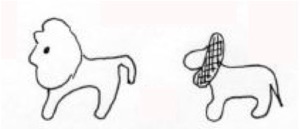
I did find this pysanka in a set of photos of the pysanky of Olena Kulchytska, a Ukrainian artist. The collection is in a museum in Lviv, but there is no further information on the provenance of the designs, whether they are traditional or her own. This particular pysanka appears to have a lion at either end.
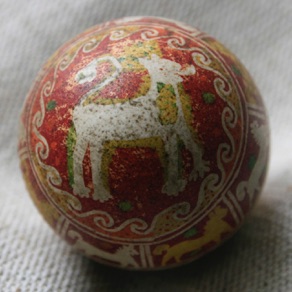
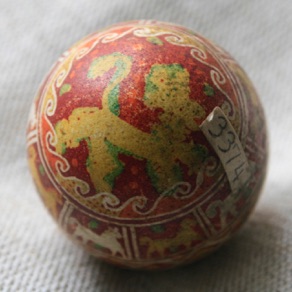
It is important to bear in mind that the Lion is the symbol of the city of Lviv–lion statues and other lion-themed features are found throughout the city in abundance. If this is an original design, that might be the reason for this particular symbol.
When motifs appear only rarely, it is hard to assign a symbolic meaning to them.
As with plant motifs, the part could often represent the whole. Women sometimes simply drew parts of animals; these symbols were a sort of shorthand, but were endowed with all the attributes of the animal represented. Ducks’ necks, rabbits’ ears, rams’ horns (below) were seen.
Animals were usually represented by their parts; in the case of rams, it was their horns. The ram’s horn is an ancient symbol, being found on Trypillian pottery from the Neolithic era.

You can see the ram’s horns symbols in these two pysanky from eastern Podillia (Vinnytsia):



The ram (sheep) was a symbol of spring rebirth, as well as of male fertility. Animal motifs are thought to bestow the best characteristics of the animal onto the bearer. In the case of the ram, these are leadership and strength.

The “teeth” motif is usually called “wolves’ teeth,” but can also be known as “hare’s teeth,” or simply “teeth.” This is usually a border motif, and consists of a row of triangles.

The mystical power of a wolf bite can be somewhat explained if we realize that the wold is one of the forms taken by the serpent (zmiya) – the god of the earth. Ancient legends suggest that a serpent’s bite can introduce evil into a person.
This pysanka is an example from the Odesa region in which the teeth are a major motif, not merely a bit of border.

Бear claws (below) are a common motif, which, according to Chaika, echo bear worship from the Paleolithic era. Bear paws, along with a bear’s head, played a role in ancient ritual worship of the god of the earth.
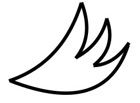
Theis pysanka from Podillia (Vinnytsia) appears to have bear paw motifs, although local usage gives it the name of “Doves’ wings.”

Another interesting motif is the oxen (bull’s) eye, which is portrayed by two or three concentric circles. Binyashevsky interprets this symbol as the eye of Veles, who was the ancient Ukrainian protector of livestock, and thus the god of of prosperity. This symbol was meant to protect all agriculture.
Below are examples in pysanky from Lvivshchyna, Sumshchyna and Polissia.



BIRDS
Birds were the harbingers of spring, and are often depicted on pysanky. Some ancient beliefs associated the ancient sun god with birds, and his handprint was said to be similar to a bird’s claw.

Birds were thought to be able to fly to heaven, and are sometimes pictured o Hutsul pysanky carrying letters in their beaks as they fly upwards.

However, birds were usually pictured perched, not flying, on pysanky (with the exception of swallows, right, who are always shown in flight). While most animals are depicted on pysanky only by their most characteristic features, wild birds were shown whole, and in profile.


These are magpies on a pysanka from Poltava (left), and non-specific birds from other areas.


A few examples of bird motifs found on traditional Ukrainian folk pysanky.


More examples of bird motifs and information about their symbolism can be found here.
POULTRY
In Ukrainian folk pysankarstvo it is typical to depict only the most characteristic features of an animal, rather than the entire animal. Often this results in only “heads and paws” being depicted. While chickens are sometime portrayed whole on pysanky, ducks and geese almost never are. They are usually represented by their feet or, less commonly, their necks.

For talismanic purposes, bird parts (eyes, feet, beaks, combs, feathers) carry the same meaning as the entire bird. Roosters, who greet the dawn, are sun symbols. Chickens, ducks, geese are fertility symbols.
Domestic fowl can also be seen whole, as on these Hutsul pysanky.


More examples of poultry motifs and information about their symbolism can be found here.
FISH
The fish motif is relatively common on traditional in Carpathian areas, where zoomorphic motifs are most commonly seen. It is an ancient symbol of life, health and fertility. Pagan cultures associated the fish with vigilance. Fish feature often in Ukrainian folk tales; in many stories, a fish assists the hero in his quest.
In more recent times, the fish has taken on Christian meanings, as, in the christian tradition, the fish is a symbol of Christ.
Traditional fish motifs found on Ukrainian folk pysanky are fairly simply, elongated creatures. There may be eye markings, fins, a tail. They may have some spots or stripes.

Diasporan (non-traditional) fish motifs tend to be more ornate and geometrically complex, as would be expected with their decorative, rather than talismanic, origins.
A few examples of fish motifs on pysanky.

More examples of fish motifs and information about the symbolism can be found here.
INSECTS
“Pavuchky” are the most common “insect” motif found on pysanky (they are not actually true insects, because they have eight legs, not six) and are common in Ukrainian folk art in general. Spider motifs generally have a centrifugal or complex net-like composition, resembling the outline of a spider and its web or a swastika.
The pysanka from eastern Polissia at the top of the page is an example of this type, as is this one from from the Odesa region (both from Binyashevsky):
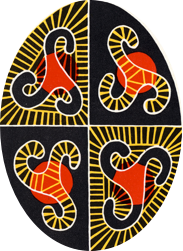
As with most zoomorphic motifs, the “pavuky” on pysanky rarely look anything like an actual living spider. They are highly stylized, and the appellation is given to various odd-looking creatures with any number of legs from three on up, as on these pysanka from Podillia and Khersonshchyna:
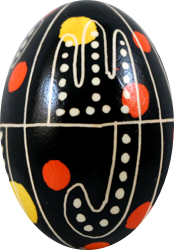
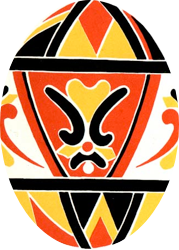
The butterfly is not a symbol found on traditional pysanky. There are several traditional pysanky which can be found in the literature which have been given the name “metelyky” or “babky,” but these names do not appear to be original, and may be later reinterpretations by various authors. These examples are from Binyashevsky, and are three-winged; the original designs are from the Hutsul region and Kurshchyna and are probably version of the “Trylyst.”
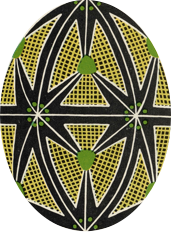
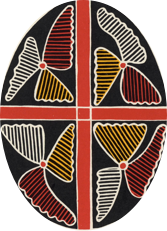
Bees can be seen on diasporan pysanky with some frequency, but not on traditional folk pysanky. Other insects are also uncommon and non-traditional.
More examples of insect motifs and information about the symbolism can be found here.
SNAKE
The snake seen on pysanky is actually a serpent (zmiya), a representation of the ancient pre-christian god of earthly waters. It is a protective motif, and is represented by a spiral or sigma (S) shape.
The snake symbol on a pysanka brings protection; my nephew created this pysanka to protect his house.

More examples of snake motifs and information about the symbolism can be found in the section about the zmiya/serpent here.
REPTILES
With the exception of snake/zmiya motifs, reptiles are not often seen on pysanky. There are a few odd pysanky, though, which do depict them. The first is this strange Hutsul one from Elyjiw--there is a row of turtles and what appear to be snakes with feet around the perimeter:
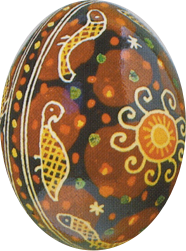
There are also a number of pysanky in Vira Manko’s book called “tortoise,” although none are as anatomically correct as the ones in the pysanka above. Some do look a bit like the creatures, others only vaguely so, and seem to be renamed svarha/cross combinations.
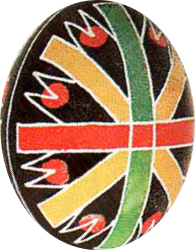
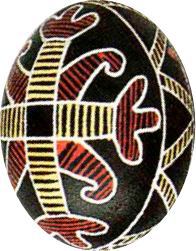
More examples of reptile motifs and information about the symbolism can be found here.
FROGS
Frog motifs are not often seen on pysanky. They are a not uncommon motif in embroidery, as in Podillia, where they are diamond shapes with extended crossed sides. Selivachov gives these two examples of frog motifs on pysanky, also from Podillia. He describes these motifs as bilateral signs, with lines radiating from a central axis at an angle of 45°. This is one such pysanka from Elyjiw; it is called «Жабки» (Frogs), and is from Bilousivka, Тulchynskyi raion, Vinnytsia oblast (Podillia).
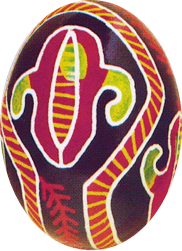
More examples of FROG motifs and information about the symbolism can be found here.
Back to MAIN Symbolism home page.
Back to MAIN Pysanka home page.
Back to Pysanka Index.